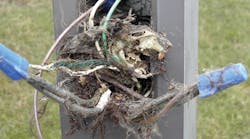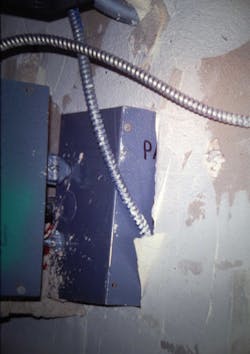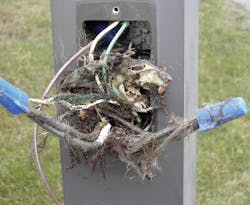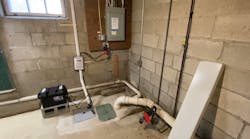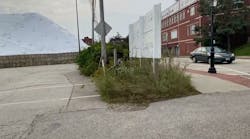All references are based on the 2011 edition of the NEC.
The Blueprints Made Me Do It
I think someone may have misread the blueprints on this job. Somehow, this junction box ended up right in the middle of this wall. In fact, it appears as though the wall was constructed right around the box. Maybe it was the electrician, or maybe it was the carpenter who made the mistake. But no matter who did it, it’s still classified as a Code violation — because it’s virtually impossible to access the wiring in this box without having to bust open the wall.
Section 314.29 states, “Boxes, conduit bodies, and handhole enclosures shall be installed so that the wiring contained in them can be rendered accessible without removing any part of the building or, in underground circuits, without excavating sidewalks, paving, earth, or other substance that is to be used to establish the finished grade.” We could also say this installation violates 314.20, which requires boxes employing a flush-type cover or faceplate installed in walls or ceilings with a surface of concrete, tile, gypsum, plaster, or other noncombustible material, to be “installed so that the front edge of the box, plaster ring, extension ring, or listed extender will not be set back of the finished surface more than a ¼ in.”
Skeletons in the Closet
Or should I say handhole? I chose this photo in keeping with the Halloween spirit of October. You must agree that it’s pretty creepy!
I got called to an office building to troubleshoot why all of the parking lot lights had suddenly stopped working. The circuit breaker was tripped. This is what I found in the process of opening all of the handholes on the poles in order to check the circuit wiring.
This poor squirrel had gotten itself inside this pole by pulling off the pole cap and then climbing down the inside of the pole. A tree next to the pole provided easy access for the squirrel to get on top of the light fixture and the pole. Unfortunately, once he was inside, he couldn’t get himself out. So he did what most rodents do — begin to gnaw on the wire insulation. Once the time clock turned on the power to this 277V circuit, it was “lights out” for the poor squirrel.
On a different note, there is actually a Code violation here. The white tape used to identify the insulated 8 AWG grounded conductor is a violation of 200.6(A). White or gray markings at wire terminations are permitted for 4 AWG and larger conductors in accordance with 200.6(B)(4).
